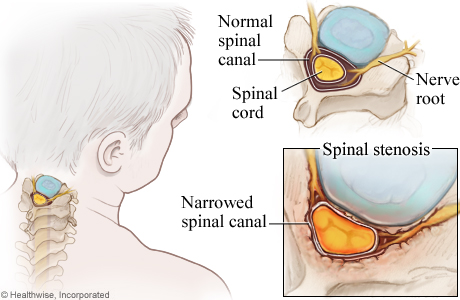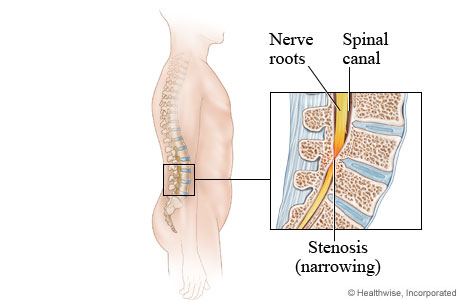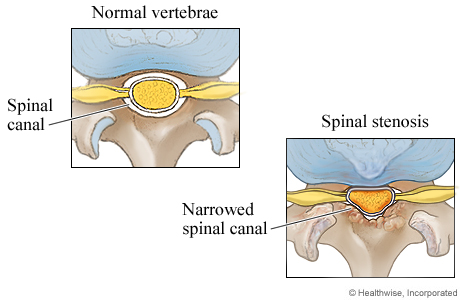Spinal stenosis
Spinal stenosis is the narrowing of the spinal canal. It can be caused by several problems, including overgrowth of bone or other tissue or by a herniated disc. When the spinal canal gets too narrow, it can squeeze and irritate your spinal cord or nearby nerve roots.
Spinal stenosis can cause pain, numbness, or weakness in your legs, buttocks, arms, or neck, depending on what area of your spine is affected.
Types
What is cervical spinal stenosis?
Cervical spinal stenosis is the narrowing of the spinal canal in the neck.
The spinal canal is the open area in the bones (vertebrae) that make up the spinal column. The spinal cord is a collection of nerves that runs through the spinal canal from the base of the brain to the lower back. These nerves allow us to feel, to move, and to control the bowel and bladder and other body functions.
The seven vertebrae between the head and the chest make up the cervical spine. In cervical spinal stenosis, the spinal canal narrows and can squeeze and compress the nerve roots where they leave the spinal cord, or it may compress or damage the spinal cord itself.
Squeezing the nerves and cord in the cervical spine can change how the spinal cord functions and cause pain, stiffness, numbness, or weakness in the neck, arms, and legs. It can also affect your control of your bowels and bladder.
Spinal Stenosis: Cervical

When the spinal canal becomes narrower (stenosis), the spinal cord and/or nerve roots get squeezed.
What is lumbar spinal stenosis?
Lumbar spinal stenosis is a narrowing of the spinal canal in the lower back, known as the lumbar area.
The spine is made up of bones called vertebrae. The spinal cord runs through an opening in the bones called the spinal canal. Sometimes bones and tissue grow into this canal and press on the spinal cord and/or the nerves that branch out from it. This causes pain, numbness, or weakness in the back, buttocks, legs, and feet.
Spinal Stenosis: Lumbar


When the spinal canal in the low back becomes narrower (stenosis), the nerve roots get squeezed.
Care
Spinal Stenosis: Home Treatment and Physical Therapy
Treatment
How is cervical spinal stenosis treated?
In mild cases of spinal stenosis, symptoms can usually be controlled with medicine to relieve pain, exercise to maintain strength and flexibility, and physical therapy. If your symptoms are severe, you have progressive weakness of your muscles, or the pictures of your spine show that your spinal cord or nerves are being tightly squeezed, your doctor is likely to recommend decompressive surgery to relieve the pressure. This surgery may be done from the front or the back of the neck. It involves removing some of the disc, bone, and/or tissue that may be pressing on the nerve roots. Vertebrae are often joined together surgically (fused) to provide stability to the spine.
How is lumbar spinal stenosis treated?
Treatments for lumbar spinal stenosis include:
- Medicines to help manage pain.
- Medicines include NSAIDs and acetaminophen.
- Physical therapy.
- This includes stretching and strength exercises that may reduce pain and other symptoms.
- Steroid shots (injections).
- If other nonsurgical treatments haven't worked, these shots are sometimes tried to help leg pain by reducing inflammation in the nerve root. They may work for some people. But they may work for only a short time.
- Surgery to relieve pressure on the nerve roots.
- Unless the symptoms are disabling, most people with lumbar spinal stenosis don't need surgery. Surgery is most often used to relieve pain, numbness, or weakness in the legs.
- Interspinous process devices.
- These small devices can be put between the bones of the spine to take pressure off the nerve roots. This may be an option for some people.
Exercise and changing the way you do your activities may also help you feel better.
Back Surgery for Spinal Stenosis: Before Your Surgery
Copyrighted material adapted with permission from Healthwise, Incorporated. This information does not replace the advice of a doctor.
